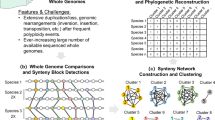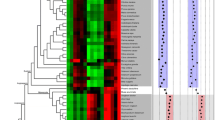Abstract.
In this work, we investigated (1) the compositional distributions of all available nuclear coding sequences (and of their three codon positions) of six dicots and four Gramineae; this considerably expanded our knowledge about the differences previously seen between these two groups of plants; (2) the compositional correlations of homologous genes from dicots and from Gramineae, as well as from both groups; all correlations were characterized by very good coefficients, with slopes close to unity in the former two cases and very high in the last; (3) the compositional transition that accompanied the emergence of Gramineae from an ancestral monocot; (4) the compositional correlations between exons and introns, which were very good in Gramineae, but only poor to good in dicots; and (5) the compositional profiles of homologous genes from angiosperms, which were characterized by a series of peaks (exons) and valleys (introns) separated by 15–20% GC. The conservative and transitional modes of compositional evolution in plant genes and their general implications are discussed.
Similar content being viewed by others
Author information
Authors and Affiliations
Additional information
Received: 24 June 1997 / Accepted: 20 August 1997
Rights and permissions
About this article
Cite this article
Carels, N., Hatey, P., Jabbari, K. et al. Compositional Properties of Homologous Coding Sequences from Plants. J Mol Evol 46, 45–53 (1998). https://doi.org/10.1007/PL00006282
Issue Date:
DOI: https://doi.org/10.1007/PL00006282




